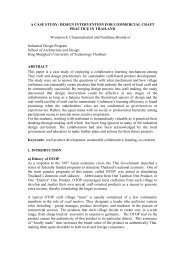soa+d research manual - School of Architecture and Design, KMUTT
soa+d research manual - School of Architecture and Design, KMUTT
soa+d research manual - School of Architecture and Design, KMUTT
You also want an ePaper? Increase the reach of your titles
YUMPU automatically turns print PDFs into web optimized ePapers that Google loves.
<strong>of</strong> knowledge. in some areas <strong>of</strong> anthropological inquiry, the<br />
<strong>research</strong> thesis emerges <strong>and</strong> is shaped whilst drafting the<br />
review rather than before it.<br />
An alternative is to work — counterintuitively perhaps —<br />
from presentation to paper. given that the typical conference<br />
presentation is some twenty minutes long, this has the<br />
advantage <strong>of</strong> focusing your attention on what needs to said in<br />
order to establish, further <strong>and</strong> defend your argument. To this<br />
extent the approach can pay double dividends. firstly, it saves<br />
time <strong>and</strong> energy you would spend writing up aspects <strong>of</strong> your<br />
<strong>research</strong> that might not be directly relevant to your confernce<br />
paper. And, secondly, it helps clarify your thinking, sculpt your<br />
argument <strong>and</strong> develop its fit for your audience<br />
in practical terms, i <strong>of</strong>ten begin by carefullyreviewing the<br />
abstract. from this i attempt to unravel the promise it contains<br />
from the broader network <strong>of</strong> ideas, methods <strong>and</strong> discoveries<br />
that comprise the <strong>research</strong> overall (rather than the aspect(s)<br />
<strong>of</strong> it to be addressed in the paper). usually this results in<br />
a scrappy, colour-coded diagram <strong>of</strong> that maps key ideas,<br />
references, relationships <strong>and</strong> structures. from this, i then<br />
work out an extended draft presentation using index cards<br />
(avoid powerpoint at this stage as it introduces delusions <strong>of</strong><br />
completion <strong>and</strong> finish into what needs to be a fairly messy<br />
process). When ‘read’ this one comes in at about 50 minutes<br />
<strong>and</strong> comprises between 20 to 30 slides. i then try to reduce<br />
this dramatically to the requisite 20 minutes by relentlessly<br />
shaving away unecessary detail, digressions, pomposities <strong>and</strong><br />
affectations, <strong>and</strong> redundant links in the chain <strong>of</strong> argument.<br />
The result? A presentation comprising somewhere between<br />
6 <strong>and</strong> 15 (content) slides. somewhere in between these two<br />
poles, lies the conference paper, made lean <strong>and</strong> mean by the<br />
process <strong>of</strong> editing yet containing enough detail to communicate<br />
<strong>and</strong> contextualise the <strong>research</strong>. Obviously perhaps, but<br />
worth restating nonetheless, the paper itself is best written<br />
iteratively <strong>and</strong> will benefit from the advice <strong>of</strong> a critical friend at<br />
the draft stage.<br />
5<br />
THE CONFERENCE PRESENTATION<br />
REsEARch NOTEs<br />
27<br />
WHAT IS A CONFERENCE PRESENTATION?<br />
Presenting a paper at conference is an important moment for<br />
you <strong>and</strong> the progress <strong>of</strong> your <strong>research</strong>. it is here that you enter<br />
into dialogue with a critical <strong>and</strong> scholarly community <strong>and</strong> your<br />
argument or findings are scrutinized by your academic peers.<br />
A good presentation will stimulate discussion within—<strong>and</strong><br />
sometimes even beyond—the session. it will encourage your<br />
audience to read your paper in full. many useful suggestions <strong>and</strong><br />
significant contacts emerge in this way. it is also, <strong>of</strong> course, an<br />
academic rite <strong>of</strong> passage.<br />
it is important, therefore, that you pay great attention to the<br />
process <strong>of</strong> transforming your written text into an effective <strong>and</strong><br />
engaging verbo-visual presentation. in this note, i make some<br />
suggestions that will, i hope, help you to prepare <strong>and</strong> deliver an<br />
effective <strong>and</strong> engaging presentation.<br />
THE CHALLENGE(S)<br />
At first sight the problem is a trivial one. you already have a<br />
completed conference paper, all you need to do is to make it<br />
shorter. however, the reality is somewhat different <strong>and</strong> a whole<br />
series <strong>of</strong> challenges present themselves when we attempt to<br />
transform an academic paper into a conference presentation.<br />
carefully considering <strong>and</strong> working through these is, i believe, the<br />
best way to lay the groundwork for your talk.<br />
TWENTY MINUTES IS A VERY SHORT TIME<br />
The first challenge is, perhaps, the simplest: what to leave out.<br />
A typical conference paper is between four <strong>and</strong> seven thous<strong>and</strong><br />
words long. A typical conference presentation lasts twenty<br />
minutes. Research shows that a twenty minute presentation<br />
would—if read from a script—comprise approximately eight<br />
sides <strong>of</strong> double-spaced, conventionally margined, twelve point<br />
text (set in a st<strong>and</strong>ard serif font such as Times New Roman),<br />
approximately two <strong>and</strong> a half thous<strong>and</strong> words. The challenge<br />
is to distill your paper, to make it shorter in such a way as to<br />
preserve its fundamental insights.<br />
Experienced <strong>research</strong>ers tend to address this challenge in one <strong>of</strong><br />
two ways:<br />
The first is to summarise each section <strong>of</strong> the paper (introduction,<br />
literature, methodology <strong>and</strong> results, for example). however,<br />
whilst this approach appears to be the simplest it is not without



